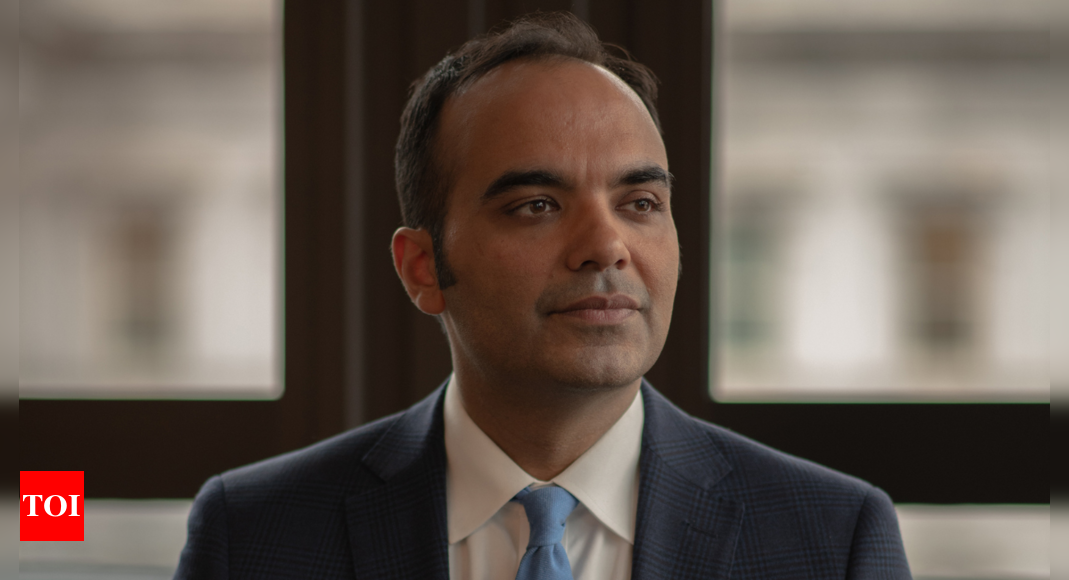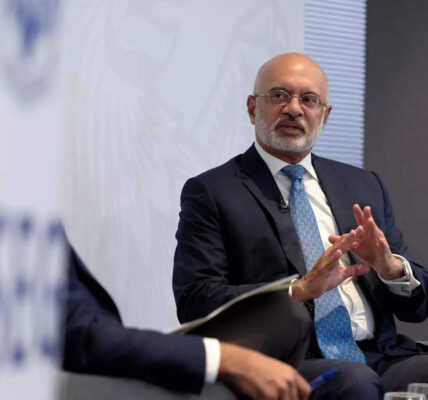United Nations: India’s growth rate is projected to be 6.2 percent in 2024 due to strong domestic demand and strong growth in manufacturing and services sectors, the United Nations has said.
The United Nations World Economic Situation and Prospects (WESP) 2024 report, launched here on Thursday, said GDP in South Asia is projected to grow by 5.2 per cent in 2024, driven by strong expansion in India, Which remains the fastest. The largest growing economy in the world.
“Amid strong domestic demand and robust growth in the manufacturing and services sectors, growth in India is projected to reach 6.2 percent in 2024, slightly lower than the 6.3 percent forecast for 2023,” the report said.
India’s GDP is expected to grow by 6.6 percent in 2025. Economic growth in India is projected to be “strong” at 6.2 percent this year, mainly supported by resilient private consumption and strong public investment, the report said.
It said manufacturing and services sectors will continue to support the economy, but irregular rainfall patterns are likely to dampen agricultural output.
“The Indian economy has outperformed its counterparts not only this year but again in the last few years,” Hamid Rasheed, head of the Global Economic Analysis and Policy Division (UN DESA), a global monitoring arm, told reporters.
He said India’s economic growth has consistently remained above six percent and “we believe this will continue in 2024 and 2025 as well.”
Rashid said that although inflation was relatively high for India, it did not need to raise rates so much and inflation has come down significantly.
“This has allowed the government to maintain the necessary fiscal support,” he said, adding, “We have not seen significant fiscal adjustment or fiscal retrenchment in India.”
“Overall, domestic consumption is up, household spending is up, employment situation has improved significantly. Therefore, we are very optimistic about India’s growth outlook in the near future.
In response to a question on the factors restraining India’s economic growth, Shantanu Mukherjee, director of the Economic Analysis and Policy Division, cited India’s GDP growth rate over the four years from 2022-2025 and said: “I am not sure that 7.7. %, 6.3%, 6.2% and 6.6% are definitely holding something back.”
“In a sort of abstract sense, if you grow too fast for India’s size and complexity, there is a risk of the economy overheating,” he said.
Mukherjee said the Indian government has recently revised its tax collection systems and “they have definitely helped and given a more stable playing field for businesses and other initiatives to progress.” Highlighting the risks facing the economy, he said some of them are more global in nature.
“India still remains a largely agricultural economy in many senses. And being in the tropics, it is very sensitive to climate change. El Nino is a frequent phenomenon but is becoming more frequent due to climate change. So should agricultural production take a hit, it could cause major disruption to the economy.”
Mukherjee said that although he does not anticipate such a shock, if such a shock does occur, it could be problematic.
“One reason the consumer price index in India remained relatively within range and the central bank could not raise interest rates too much was that food prices and fuel prices remained relatively stable. Therefore, any such shock will adversely impact the economy,” he said.
Consumer price inflation in India is expected to decline from 5.7 percent in 2023 to 4.5 percent in 2024, which will remain within the two to six percent medium-term inflation target range set by the central bank.
“The risk of an increase in inflation in the coming months cannot be ruled out, as the pace of disinflation could be disrupted by a potential rise in commodity prices and the adverse impact of climate events on food prices,” the report said.
Despite improvements in some countries, the labor market situation in South Asia remains fragile in 2023.
In India, labor market indicators have improved over the year, with labor force participation rising in August to its highest rate since the beginning of the pandemic, the report said, citing the Reserve Bank of India.
The unemployment rate averaged 7.1 percent in September, the lowest in a year, with unemployment falling in rural areas despite weak monsoon rains. It said the youth unemployment rate declined significantly during the first quarter of 2023 to its lowest since the pandemic.
The report also said that the Reserve Bank of India is cautious about opening the financial markets of the country and is implementing appropriate risk management system.
The United Nations said global economic growth is projected to slow from an estimated 2.7 percent in 2023 to 2.4 percent in 2024, down from the pre-pandemic growth rate of three percent.
This latest forecast comes as global economic performance in 2023 exceeds expectations. However, last year’s stronger-than-expected GDP growth masked short-term risks and structural weaknesses.
Mukherjee told reporters that the better-than-expected performance for 2023 is mainly driven by several large economies, particularly the US, but also Brazil, India and Mexico.
A major UN economic report presents a gloomy economic outlook for the near term. Persistently high interest rates, worsening conflicts, sluggish international trade and growing climate disasters pose significant challenges to global development.
The year “2024 should be the year we get out of this quagmire. “By unlocking bigger, bolder investments, we can advance sustainable development and climate action and put the global economy on a stronger growth path for all,” said UN Secretary-General Antonio Guterres.
The United Nations World Economic Situation and Prospects (WESP) 2024 report, launched here on Thursday, said GDP in South Asia is projected to grow by 5.2 per cent in 2024, driven by strong expansion in India, Which remains the fastest. The largest growing economy in the world.
“Amid strong domestic demand and robust growth in the manufacturing and services sectors, growth in India is projected to reach 6.2 percent in 2024, slightly lower than the 6.3 percent forecast for 2023,” the report said.
India’s GDP is expected to grow by 6.6 percent in 2025. Economic growth in India is projected to be “strong” at 6.2 percent this year, mainly supported by resilient private consumption and strong public investment, the report said.
It said manufacturing and services sectors will continue to support the economy, but irregular rainfall patterns are likely to dampen agricultural output.
“The Indian economy has outperformed its counterparts not only this year but again in the last few years,” Hamid Rasheed, head of the Global Economic Analysis and Policy Division (UN DESA), a global monitoring arm, told reporters.
He said India’s economic growth has consistently remained above six percent and “we believe this will continue in 2024 and 2025 as well.”
Rashid said that although inflation was relatively high for India, it did not need to raise rates so much and inflation has come down significantly.
“This has allowed the government to maintain the necessary fiscal support,” he said, adding, “We have not seen significant fiscal adjustment or fiscal retrenchment in India.”
“Overall, domestic consumption is up, household spending is up, employment situation has improved significantly. Therefore, we are very optimistic about India’s growth outlook in the near future.
In response to a question on the factors restraining India’s economic growth, Shantanu Mukherjee, director of the Economic Analysis and Policy Division, cited India’s GDP growth rate over the four years from 2022-2025 and said: “I am not sure that 7.7. %, 6.3%, 6.2% and 6.6% are definitely holding something back.”
“In a sort of abstract sense, if you grow too fast for India’s size and complexity, there is a risk of the economy overheating,” he said.
Mukherjee said the Indian government has recently revised its tax collection systems and “they have definitely helped and given a more stable playing field for businesses and other initiatives to progress.” Highlighting the risks facing the economy, he said some of them are more global in nature.
“India still remains a largely agricultural economy in many senses. And being in the tropics, it is very sensitive to climate change. El Nino is a frequent phenomenon but is becoming more frequent due to climate change. So should agricultural production take a hit, it could cause major disruption to the economy.”
Mukherjee said that although he does not anticipate such a shock, if such a shock does occur, it could be problematic.
“One reason the consumer price index in India remained relatively within range and the central bank could not raise interest rates too much was that food prices and fuel prices remained relatively stable. Therefore, any such shock will adversely impact the economy,” he said.
Consumer price inflation in India is expected to decline from 5.7 percent in 2023 to 4.5 percent in 2024, which will remain within the two to six percent medium-term inflation target range set by the central bank.
“The risk of an increase in inflation in the coming months cannot be ruled out, as the pace of disinflation could be disrupted by a potential rise in commodity prices and the adverse impact of climate events on food prices,” the report said.
Despite improvements in some countries, the labor market situation in South Asia remains fragile in 2023.
In India, labor market indicators have improved over the year, with labor force participation rising in August to its highest rate since the beginning of the pandemic, the report said, citing the Reserve Bank of India.
The unemployment rate averaged 7.1 percent in September, the lowest in a year, with unemployment falling in rural areas despite weak monsoon rains. It said the youth unemployment rate declined significantly during the first quarter of 2023 to its lowest since the pandemic.
The report also said that the Reserve Bank of India is cautious about opening the financial markets of the country and is implementing appropriate risk management system.
The United Nations said global economic growth is projected to slow from an estimated 2.7 percent in 2023 to 2.4 percent in 2024, down from the pre-pandemic growth rate of three percent.
This latest forecast comes as global economic performance in 2023 exceeds expectations. However, last year’s stronger-than-expected GDP growth masked short-term risks and structural weaknesses.
Mukherjee told reporters that the better-than-expected performance for 2023 is mainly driven by several large economies, particularly the US, but also Brazil, India and Mexico.
A major UN economic report presents a gloomy economic outlook for the near term. Persistently high interest rates, worsening conflicts, sluggish international trade and growing climate disasters pose significant challenges to global development.
The year “2024 should be the year we get out of this quagmire. “By unlocking bigger, bolder investments, we can advance sustainable development and climate action and put the global economy on a stronger growth path for all,” said UN Secretary-General Antonio Guterres.






